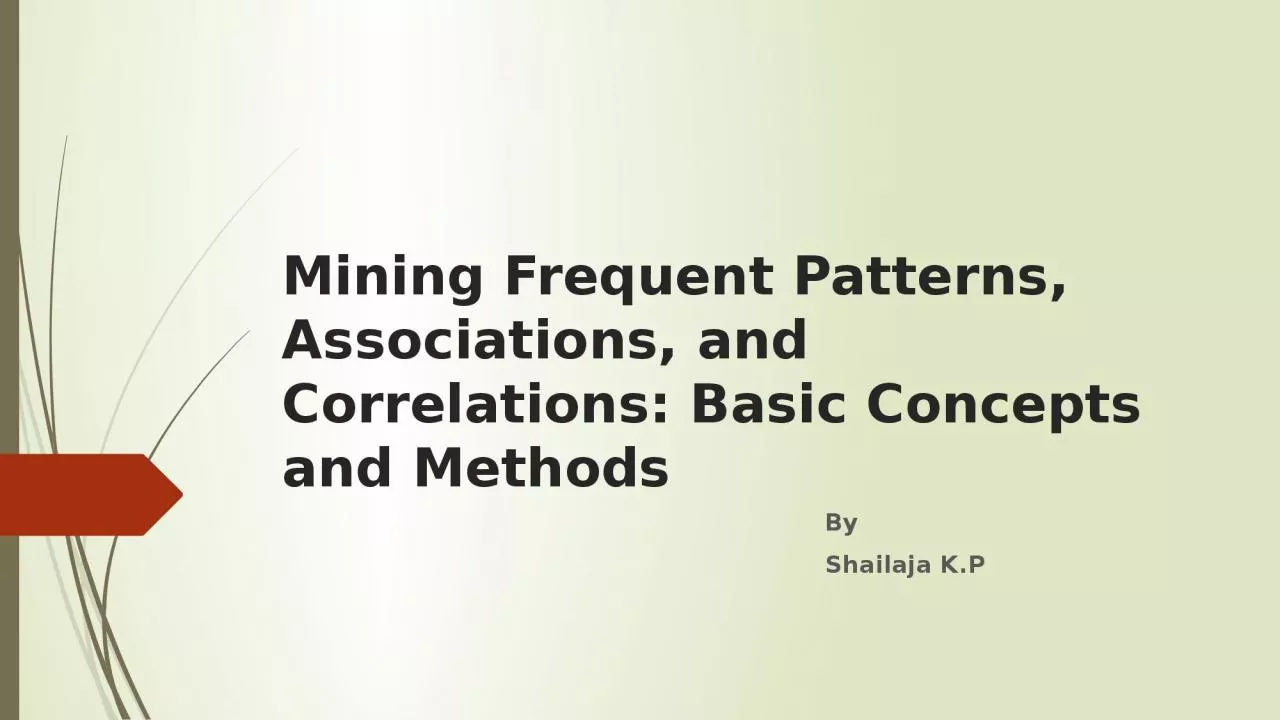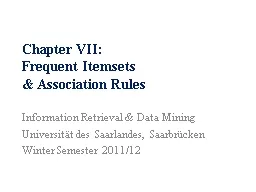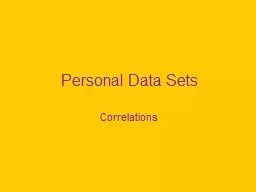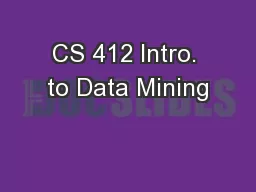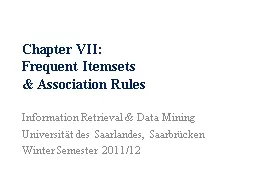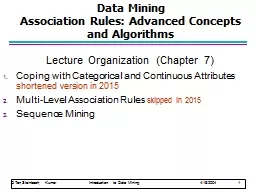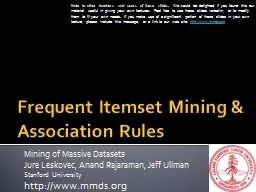PPT-Mining Frequent Patterns, Associations, and Correlations: Basic Concepts and Methods
Author : luna | Published Date : 2023-06-25
By Shailaja KP Introduction Imagine that you are a sales manager at AllElectronics and you are talking to a customer who recently bought a PC and a digital camera
Presentation Embed Code
Download Presentation
Download Presentation The PPT/PDF document "Mining Frequent Patterns, Associations, ..." is the property of its rightful owner. Permission is granted to download and print the materials on this website for personal, non-commercial use only, and to display it on your personal computer provided you do not modify the materials and that you retain all copyright notices contained in the materials. By downloading content from our website, you accept the terms of this agreement.
Mining Frequent Patterns, Associations, and Correlations: Basic Concepts and Methods: Transcript
By Shailaja KP Introduction Imagine that you are a sales manager at AllElectronics and you are talking to a customer who recently bought a PC and a digital camera from the store What should you recommend to her next . Correlation Objectives i Calculate correlations i Calculate correlations for subgroups using split file i Create scatterplots with lines of best fit for subgroups and multiple correlations Correlation The first infer Prajwal Shrestha. Department of Computer Science. The . University . of Vermont. Spring 201. 5. Original Authors. This presentation is based on the paper. Zaki. MJ (2002). Efficiently mining frequent trees in a forest. . in Data Streams . at Multiple Time Granularities. CS525 Paper Presentation. Presented by:. Pei Zhang, . Jiahua. Liu, . Pengfei. . Geng. and . Salah. Ahmed. Authors: Chris . Giannella. , . Jiawei. Debapriyo Majumdar. Data Mining – Fall 2014. Indian Statistical Institute Kolkata. August 4 and 7, 2014. Transaction id. Items. 1. Bread, Ham, Juice,. Cheese, Salami, Lettuce. 2. Rice, . Dal, Coconut, Curry leaves, Coffee, Milk, Pickle. Pasring. Reporters: R98922004 . Yun-Nung. Chen,. R98922033 Yu-Cheng Liu. Reference. Ming Actor Correlations with Hierarchical Concurrence Parsing (ICASSP 2010). Kun Yuan, . Hongxun. CALIFORNIA . COMMUNITY COLLEGE. STUDENT COURSE SEQUENCES. Bruce Ingraham, . EdD. CAIR 2016, Los Angeles. Frequent Patterns in CCC Student Course Sequences. Outline. Introduction. Student Typologies. Lingering at community college. . & Association Rules. Information Retrieval & Data Mining. Universität des Saarlandes, Saarbrücken. Winter Semester 2011/12. Chapter VII: . Frequent . Itemsets. & Association Rules. VII.1 Definitions. Michael Nethercutt, 2017. Subjects = Students at ECU. Sex. Spirituality. Receptivity to Pseudo-Profound Bullshit. http://. journal.sjdm.org/15/15923a/jdm15923a.pdf. . Bullshit Receptivity and Politics. Chapter 7 : Advanced Frequent Pattern Mining. Jiawei Han, Computer Science, Univ. Illinois at Urbana-Champaign. , 2017. 1. October 28, 2017. Data Mining: Concepts and Techniques. 2. Chapter 7 : Advanced Frequent Pattern Mining. . & Association Rules. Information Retrieval & Data Mining. Universität des Saarlandes, Saarbrücken. Winter Semester 2011/12. Chapter VII: . Frequent . Itemsets. & Association Rules. VII.1 Definitions. Lecture Organization (Chapter 7). Coping with Categorical and Continuous . Attributes . shortened version in 2015. Multi-Level Association Rules . skipped in . 2015. Sequence Mining . © Tan,Steinbach, Kumar Introduction to Data Mining 4/18/2004 . Frequent Itemset Mining & Association Rules Mining of Massive Datasets Jure Leskovec, Anand Rajaraman , Jeff Ullman Stanford University http://www.mmds.org Note to other teachers and users of these Slide 1/26ACM SOSP 2007Presented byIgnacio LagunaSlide 2/26Semanticand ConcurrencybugsTwo of the most difficult to detectVariable Access Correlationscan be exploited to detect these bugsMany variables Calibration from Integral Data. A.Trkov. , . R.Capote. , O. Cabellos. IAEA, Vienna, Austria. ETSII/UPM Madrid, Spain. Background. Current IAEA CIELO . covariances. based on measured differential data lead to large uncertainties in criticality benchmarks (.
Download Document
Here is the link to download the presentation.
"Mining Frequent Patterns, Associations, and Correlations: Basic Concepts and Methods"The content belongs to its owner. You may download and print it for personal use, without modification, and keep all copyright notices. By downloading, you agree to these terms.
Related Documents

